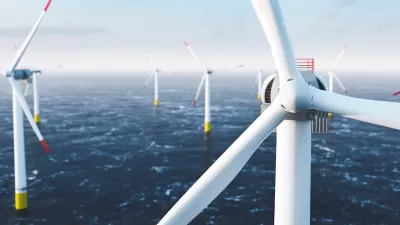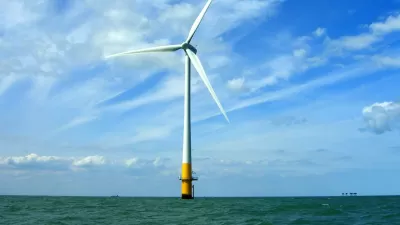Though the United States is lagging other parts of the world in offshore wind energy capacity, that trend could be set to change in the coming decade.

Herman K. Trabish shares the findings of a new report from the U.S. Department of Energy (DOE) on the scope of the offshore energy industry around the world and in the United States.
"There were 111 operating offshore wind projects around the world at the end of 2016 and, though only one was in U.S. waters, the world’s biggest developers are setting up U.S. shops," reports Trabish. Out of 12,913 megawatts of installed capacity offshore wind energy capacity, the United State accounts for only 30 megawats.
If projects in the development pipeline pan out, the United States will have a much more perceptible footprint in the world's offshore win energy portfolio, according to Trabish. "The 593 offshore wind projects in the global development pipeline at the end of 2016 represented an estimated 231,000 MW of potential capacity. The U.S. project development pipeline included 28 projects, representing 24,135 MW of potential capacity. That’s 10% of the action in a U.S. market that is barely open."
FULL STORY: Policymaker support key to offshore wind prospects in US

Alabama: Trump Terminates Settlements for Black Communities Harmed By Raw Sewage
Trump deemed the landmark civil rights agreement “illegal DEI and environmental justice policy.”

Study: Maui’s Plan to Convert Vacation Rentals to Long-Term Housing Could Cause Nearly $1 Billion Economic Loss
The plan would reduce visitor accommodation by 25% resulting in 1,900 jobs lost.

Why Should We Subsidize Public Transportation?
Many public transit agencies face financial stress due to rising costs, declining fare revenue, and declining subsidies. Transit advocates must provide a strong business case for increasing public transit funding.

Paris Bike Boom Leads to Steep Drop in Air Pollution
The French city’s air quality has improved dramatically in the past 20 years, coinciding with a growth in cycling.

Why Housing Costs More to Build in California Than in Texas
Hard costs like labor and materials combined with ‘soft’ costs such as permitting make building in the San Francisco Bay Area almost three times as costly as in Texas cities.

San Diego County Sees a Rise in Urban Coyotes
San Diego County experiences a rise in urban coyotes, as sightings become prevalent throughout its urban neighbourhoods and surrounding areas.
Urban Design for Planners 1: Software Tools
This six-course series explores essential urban design concepts using open source software and equips planners with the tools they need to participate fully in the urban design process.
Planning for Universal Design
Learn the tools for implementing Universal Design in planning regulations.
Smith Gee Studio
Alamo Area Metropolitan Planning Organization
City of Santa Clarita
Institute for Housing and Urban Development Studies (IHS)
City of Grandview
Harvard GSD Executive Education
Toledo-Lucas County Plan Commissions
Salt Lake City
NYU Wagner Graduate School of Public Service





























